VOLVO XC70 2003 Owner's Guide
Manufacturer: VOLVO, Model Year: 2003, Model line: XC70, Model: VOLVO XC70 2003Pages: 257, PDF Size: 5.33 MB
Page 31 of 257

2003 VOLVO XC70
provided with the restraint. Be sure you understand them and can use the\
device properly and
safely in this vehicle. A misused child restraint system can result in i\
ncreased injuries for both the
infant or child and other occupants in the vehicle.
A child who has outgrown the child safety seat should use the rear seat \
with the standard seat belt
fastened. Place the child on an approved cushion so that the seat belt i\
s properly located on the child's
hips (see
page 13).Legislation in your state or province may mandate the use of a child \
seat or cushion in
combination with the seat belt, depending on the child's age and/or size\
. Please check local regulations.
A specially designed and tested booster cushion (not available in Canad\
a ) for children between 50 - 80
lbs (22.7 - 36 kg) and 38 -54 inches (97 - 137 cm) in height can be \
obtained from your Volvo retailer.
If necessary, an auxiliary seat for children is available for use in the\
luggage compartment of station
wagon models. This seat is designed for two children, each weighing betw\
een 50 - 88 lbs. (23 - 40 kg)
and up to 59 inches (150 cm) in height.
WARNING!
l When using the auxiliary seat for children, both sections of the rear se\
at backrest must be secured
in the upright position.
l Do not use a booster cushion or child seat in conjunction with the auxil\
iary seat.
pg. 17 Occupant safety
Seat belt maintenance
Check periodically that the seat belts are in good condition. Use water \
and a mild detergent for cleaning.
Check seat belt mechanism function as follows: Attach the seat belt and \
pull rapidly on the strap.
Volvo Concern for Safety
Safety is the cornerstone of Volvo. Our concern dates back to 1927 when \
the first Volvo rolled off the
production line. Three-point seat belts (a Volvo invention), safety ca\
ges, and energy-absorbing impact
zones were designed into Volvo cars long before it was fashionable or re\
quired by government
regulation. We will not compromise our commitment to safety. We continue\
to seek out new safety
features and to refine those already in our cars. You can help. We would\
appreciate hearing your
suggestions about improving automobile safety. We also want to know if y\
ou ever have a safety concern
with your car. Call us in the U.S. at: 800-458-1552 or in Canada at: 800\
-663-8255.
file:///K|/ownersdocs/2003/2003_XC70/03xc70_01b.htm (8 of 14)12/30/200\
6 4:17:52 PM
Page 32 of 257

2003 VOLVO XC70
Occupant safety
How safely you drive doesn't depend on how old you are but rather on:
l How well you see.
l Your ability to concentrate.
l How quickly you make decisions under stress to avoid an accident.
The tips listed below are suggestions to help you cope with the ever cha\
nging traffic environment.
l Never drink and drive.
l If you are taking any medication, consult your physician about its poten\
tial effects on your driving
abilities.
l Take a driver-retraining course
l Have your eyes checked regularly
l Keep your windshield and headlights clean.
l Replace wiper blades when they start to leave streaks.
l Take into account the traffic, road, and weather conditions, particularl\
y with regard to stopping
distance.
Reporting Safety Defects in the U.S.
If you believe that your vehicle has a defect which could cause a crash \
or could cause injury or death,
you should immediately inform the National Highway Traffic Safety Admini\
stration (NHTSA) in
addition to notifying Volvo Cars of North America. If NHTSA receives sim\
ilar complaints, it may open
an investigation, and if it finds that a safety defect exists in a group\
of vehicles, it may order a recall and
remedy campaign. However, NHTSA cannot become involved in individual pro\
blems between you,
your retailer, or Volvo Cars of North America. To contact NHTSA, you may\
either call the Auto Safety
Hotline toll-free at 1-800-424-9393 (or 202-366-0123 in Washington, D.C\
. area) or write to: NHTSA, U.
S. Department of Transportation, Washington D.C. 20590. You can also obt\
ain other information about
motor vehicle safety from the Hotline.
Volvo strongly recommends that if your vehicle is covered under a servic\
e campaign, safety or emission
recall or similar action, it should be completed as soon as possible. Pl\
ease check with your local retailer
or Volvo Cars of North America, LLC. if your vehicle is covered under th\
ese conditions.
NHTSA can be reached at:
Internet :
http://www.nhtsa.dot.gov
Telephone:
1-888-DASH-2-DOT (1-888-327-4236) (toll free)
1-800-424-9393 (toll free)
1-202-366-0123 (in Washington DC area)
file:///K|/ownersdocs/2003/2003_XC70/03xc70_01b.htm (9 of 14)12/30/200\
6 4:17:52 PM
Page 33 of 257
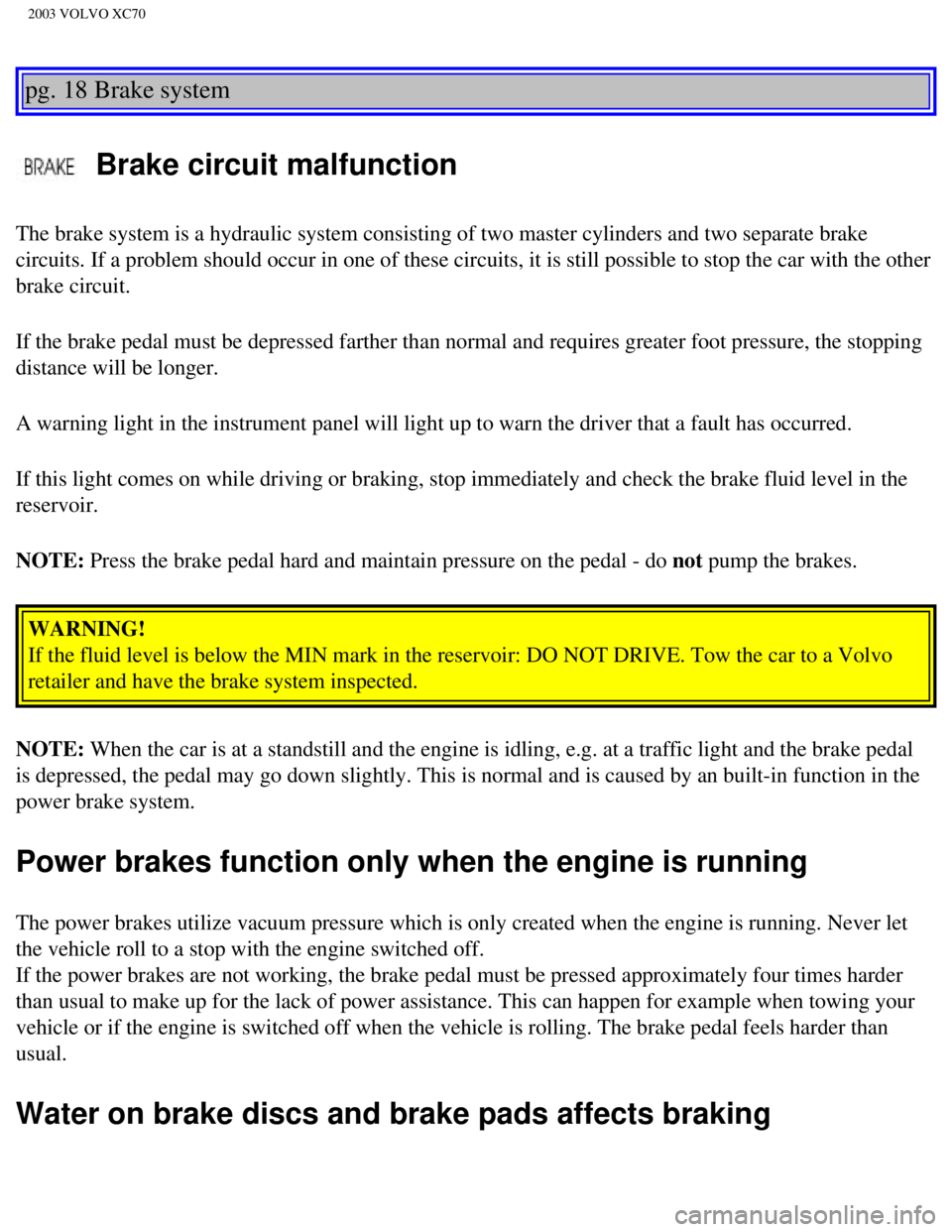
2003 VOLVO XC70
pg. 18 Brake system
Brake circuit malfunction
The brake system is a hydraulic system consisting of two master cylinder\
s and two separate brake
circuits. If a problem should occur in one of these circuits, it is stil\
l possible to stop the car with the other
brake circuit.
If the brake pedal must be depressed farther than normal and requires gr\
eater foot pressure, the stopping
distance will be longer.
A warning light in the instrument panel will light up to warn the driver\
that a fault has occurred.
If this light comes on while driving or braking, stop immediately and ch\
eck the brake fluid level in the
reservoir.
NOTE: Press the brake pedal hard and maintain pressure on the pedal - do not pump the brakes.
WARNING!
If the fluid level is below the MIN mark in the reservoir: DO NOT DRIVE.\
Tow the car to a Volvo
retailer and have the brake system inspected.
NOTE: When the car is at a standstill and the engine is idling, e.g. at a traf\
fic light and the brake pedal
is depressed, the pedal may go down slightly. This is normal and is caus\
ed by an built-in function in the
power brake system.
Power brakes function only when the engine is running
The power brakes utilize vacuum pressure which is only created when the \
engine is running. Never let
the vehicle roll to a stop with the engine switched off.
If the power brakes are not working, the brake pedal must be pressed app\
roximately four times harder
than usual to make up for the lack of power assistance. This can happen \
for example when towing your
vehicle or if the engine is switched off when the vehicle is rolling. Th\
e brake pedal feels harder than
usual.
Water on brake discs and brake pads affects braking
file:///K|/ownersdocs/2003/2003_XC70/03xc70_01b.htm (10 of 14)12/30/20\
06 4:17:52 PM
Page 34 of 257
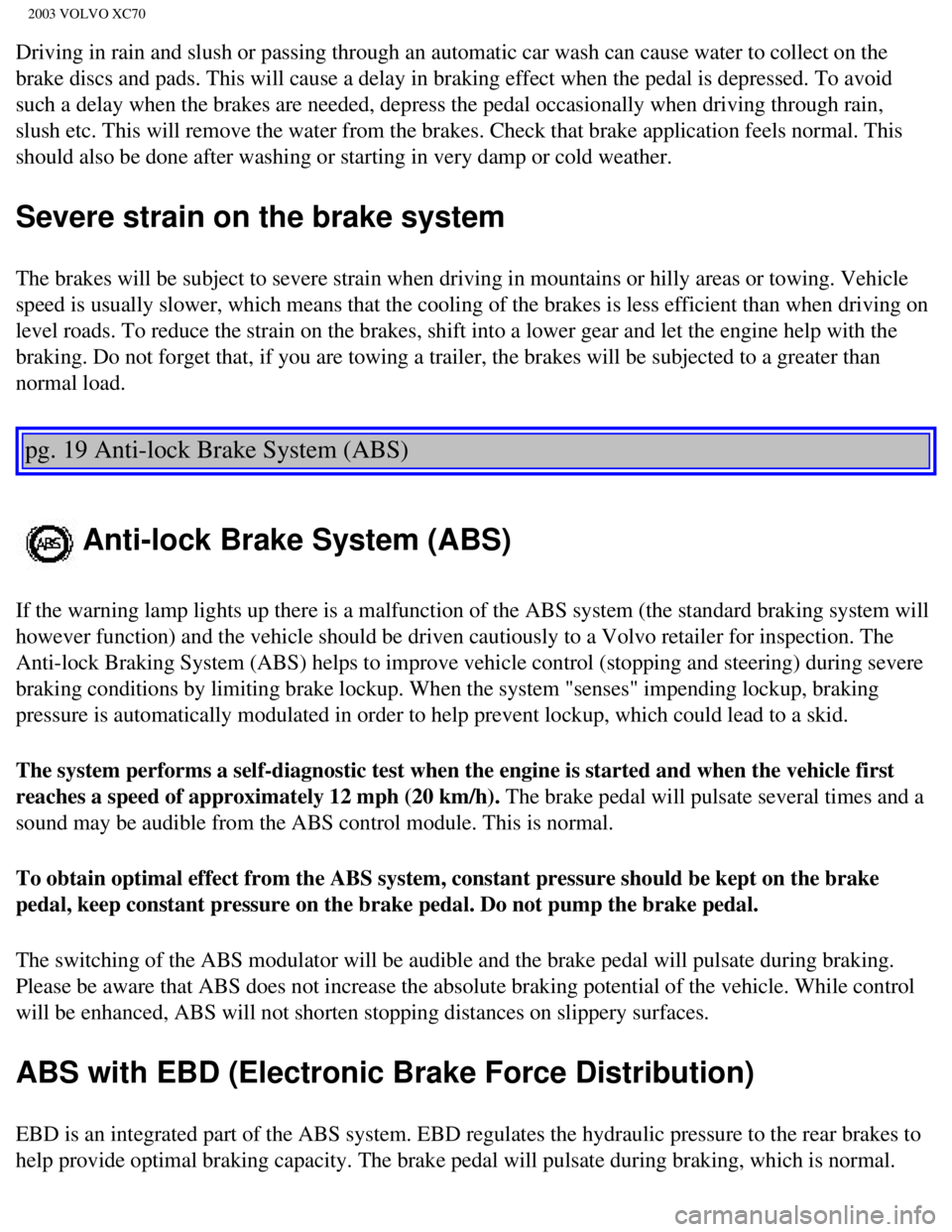
2003 VOLVO XC70
Driving in rain and slush or passing through an automatic car wash can c\
ause water to collect on the
brake discs and pads. This will cause a delay in braking effect when the\
pedal is depressed. To avoid
such a delay when the brakes are needed, depress the pedal occasionally \
when driving through rain,
slush etc. This will remove the water from the brakes. Check that brake \
application feels normal. This
should also be done after washing or starting in very damp or cold weath\
er.
Severe strain on the brake system
The brakes will be subject to severe strain when driving in mountains or\
hilly areas or towing. Vehicle
speed is usually slower, which means that the cooling of the brakes is l\
ess efficient than when driving on
level roads. To reduce the strain on the brakes, shift into a lower gear\
and let the engine help with the
braking. Do not forget that, if you are towing a trailer, the brakes wil\
l be subjected to a greater than
normal load.
pg. 19 Anti-lock Brake System (ABS)
Anti-lock Brake System (ABS)
If the warning lamp lights up there is a malfunction of the ABS system (\
the standard braking system will
however function) and the vehicle should be driven cautiously to a Volv\
o retailer for inspection. The
Anti-lock Braking System (ABS) helps to improve vehicle control (stop\
ping and steering) during severe
braking conditions by limiting brake lockup. When the system "senses" im\
pending lockup, braking
pressure is automatically modulated in order to help prevent lockup, whi\
ch could lead to a skid.
The system performs a self-diagnostic test when the engine is started an\
d when the vehicle first
reaches a speed of approximately 12 mph (20 km/h). The brake pedal will pulsate several times and a
sound may be audible from the ABS control module. This is normal.
To obtain optimal effect from the ABS system, constant pressure should b\
e kept on the brake
pedal, keep constant pressure on the brake pedal. Do not pump the brake \
pedal.
The switching of the ABS modulator will be audible and the brake pedal w\
ill pulsate during braking.
Please be aware that ABS does not increase the absolute braking potentia\
l of the vehicle. While control
will be enhanced, ABS will not shorten stopping distances on slippery su\
rfaces.
ABS with EBD (Electronic Brake Force Distribution)
EBD is an integrated part of the ABS system. EBD regulates the hydraulic\
pressure to the rear brakes to
help provide optimal braking capacity. The brake pedal will pulsate duri\
ng braking, which is normal.
file:///K|/ownersdocs/2003/2003_XC70/03xc70_01b.htm (11 of 14)12/30/20\
06 4:17:52 PM
Page 35 of 257
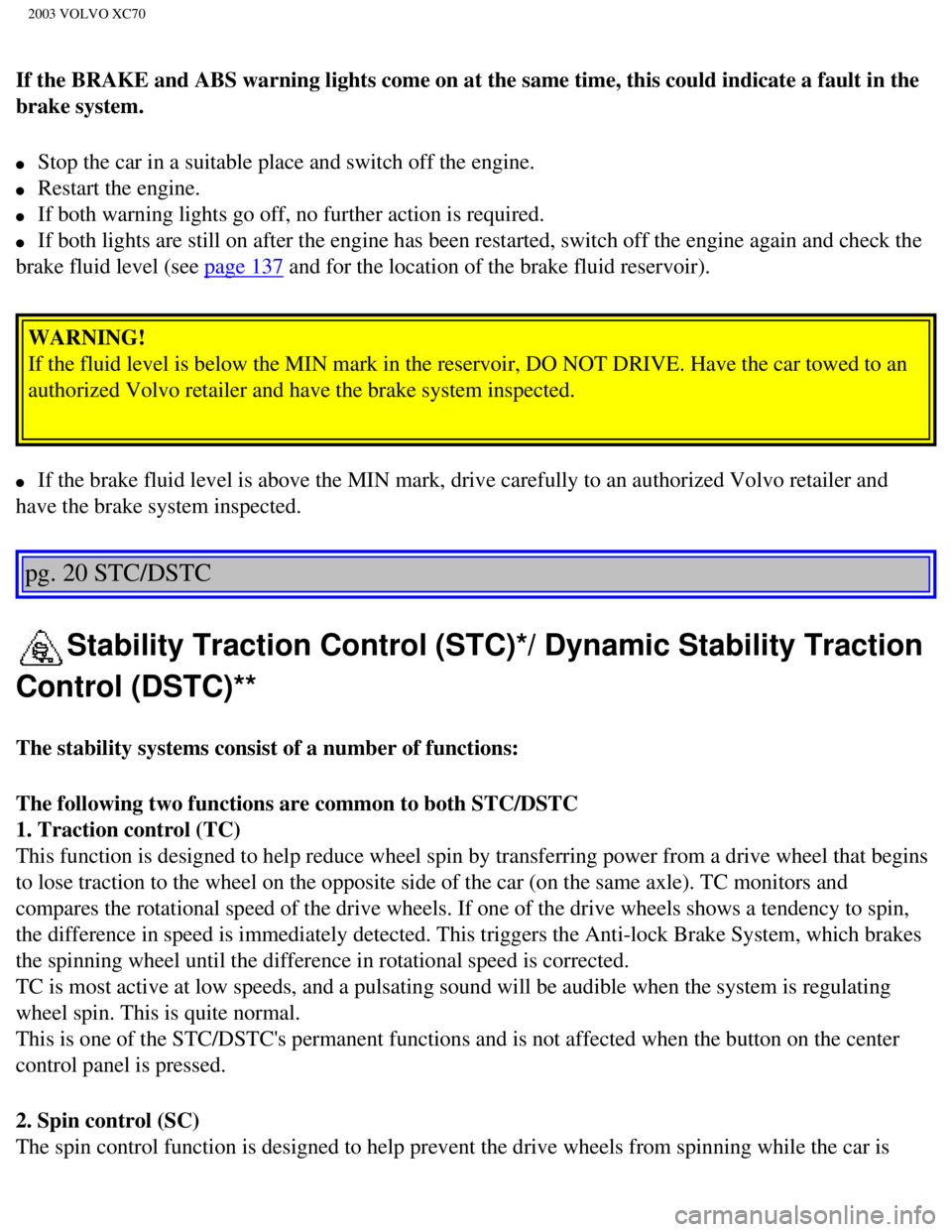
2003 VOLVO XC70
If the BRAKE and ABS warning lights come on at the same time, this could\
indicate a fault in the
brake system.
l Stop the car in a suitable place and switch off the engine.
l Restart the engine.
l If both warning lights go off, no further action is required.
l If both lights are still on after the engine has been restarted, switch \
off the engine again and check the
brake fluid level (see
page 137 and for the location of the brake fluid reservoir).
WARNING!
If the fluid level is below the MIN mark in the reservoir, DO NOT DRIVE.\
Have the car towed to an
authorized Volvo retailer and have the brake system inspected.
l If the brake fluid level is above the MIN mark, drive carefully to an au\
thorized Volvo retailer and
have the brake system inspected.
pg. 20 STC/DSTC
Stability Traction Control (STC)*/ Dynamic Stability Traction
Control (DSTC)**
The stability systems consist of a number of functions:
The following two functions are common to both STC/DSTC
1. Traction control (TC)
This function is designed to help reduce wheel spin by transferring powe\
r from a drive wheel that begins
to lose traction to the wheel on the opposite side of the car (on the s\
ame axle). TC monitors and
compares the rotational speed of the drive wheels. If one of the drive w\
heels shows a tendency to spin,
the difference in speed is immediately detected. This triggers the Anti-\
lock Brake System, which brakes
the spinning wheel until the difference in rotational speed is corrected\
.
TC is most active at low speeds, and a pulsating sound will be audible w\
hen the system is regulating
wheel spin. This is quite normal.
This is one of the STC/DSTC's permanent functions and is not affected wh\
en the button on the center
control panel is pressed.
2. Spin control (SC)
The spin control function is designed to help prevent the drive wheels f\
rom spinning while the car is
file:///K|/ownersdocs/2003/2003_XC70/03xc70_01b.htm (12 of 14)12/30/20\
06 4:17:52 PM
Page 36 of 257

2003 VOLVO XC70
accelerating. This is done by temporarily reducing engine torque to the \
drive wheels, which helps
improve tractive force.
Under certain circumstances, such as when driving with snow chains, or d\
riving in deep snow or loose
sand, it may be advisable to temporarily switch off this function for ma\
ximum tractive force. This is
done by pressing the STC/DSTC button on the center control panel for at \
least a half a second.
When the SC function has been switched off:
l The text window will briefly display "SPIN CONTROL OFF"
l The LED in the STC/DSTC button will be off.
The following two functions are only available with DSTC:
3. Active Yaw Control (AYC)
This function helps maintain directional stability, for example when cor\
nering, by braking one or more
of the wheels if the car shows a tendency to skid or slide laterally. Th\
is is done by activating the Anti-
lock Braking System. A pulsating sound will be audible when the function\
is active, which is quite
normal. If you apply the brakes while this function is active, the brake\
pedal will feel stiffer than usual.
This is also one of the DSTC system's permanent functions and is not aff\
ected when the DSTC button on
the center control panel is pressed.
4. Emergency Brake Assistance (EBA)
The EBA function is an integrated part of the DSTC system. EBA is design\
ed to provide full brake
effect immediately in the event of sudden, hard braking. The system is a\
ctivated by the speed with which
you depress the brake pedal.
When the EBA system is activated, the brake pedal will go down and press\
ure in the brake system
immediately increases to the maximum level. Maintain full pressure on th\
e brake pedal in order to utilize
the system completely. EBA is automatically deactivated when the brake p\
edal is released.
When the car has been parked for some time, the brake pedal may sink mor\
e than usual when the engine
is started. This is normal and the pedal will return to its usual positi\
on when it is released.
* Standard on all models except the T5 turbo.
** Standard on the T5 turbo, option on all other models.
pg. 21 STC/DSTC
The STC/DSTC button
file:///K|/ownersdocs/2003/2003_XC70/03xc70_01b.htm (13 of 14)12/30/20\
06 4:17:52 PM
Page 37 of 257
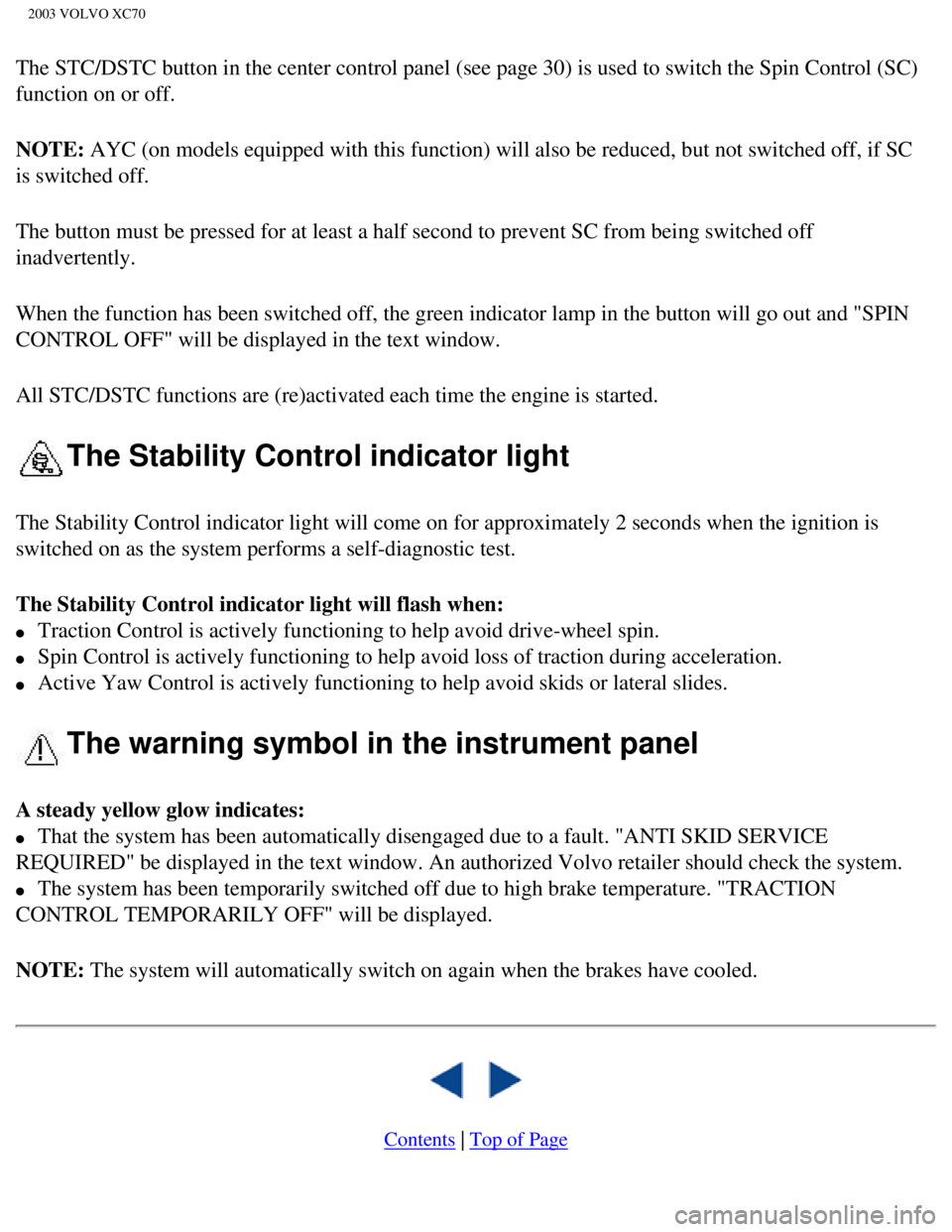
2003 VOLVO XC70
The STC/DSTC button in the center control panel (see page 30) is used \
to switch the Spin Control (SC)
function on or off.
NOTE: AYC (on models equipped with this function) will also be reduced, but\
not switched off, if SC
is switched off.
The button must be pressed for at least a half second to prevent SC from\
being switched off
inadvertently.
When the function has been switched off, the green indicator lamp in the\
button will go out and "SPIN
CONTROL OFF" will be displayed in the text window.
All STC/DSTC functions are (re)activated each time the engine is start\
ed.
The Stability Control indicator light
The Stability Control indicator light will come on for approximately 2 s\
econds when the ignition is
switched on as the system performs a self-diagnostic test.
The Stability Control indicator light will flash when:
l Traction Control is actively functioning to help avoid drive-wheel spin.\
l Spin Control is actively functioning to help avoid loss of traction duri\
ng acceleration.
l Active Yaw Control is actively functioning to help avoid skids or latera\
l slides.
The warning symbol in the instrument panel
A steady yellow glow indicates:
l That the system has been automatically disengaged due to a fault. "ANTI \
SKID SERVICE
REQUIRED" be displayed in the text window. An authorized Volvo retailer \
should check the system.
l The system has been temporarily switched off due to high brake temperatu\
re. "TRACTION
CONTROL TEMPORARILY OFF" will be displayed.
NOTE: The system will automatically switch on again when the brakes have cool\
ed.
Contents | Top of Page
file:///K|/ownersdocs/2003/2003_XC70/03xc70_01b.htm (14 of 14)12/30/20\
06 4:17:52 PM
Page 38 of 257
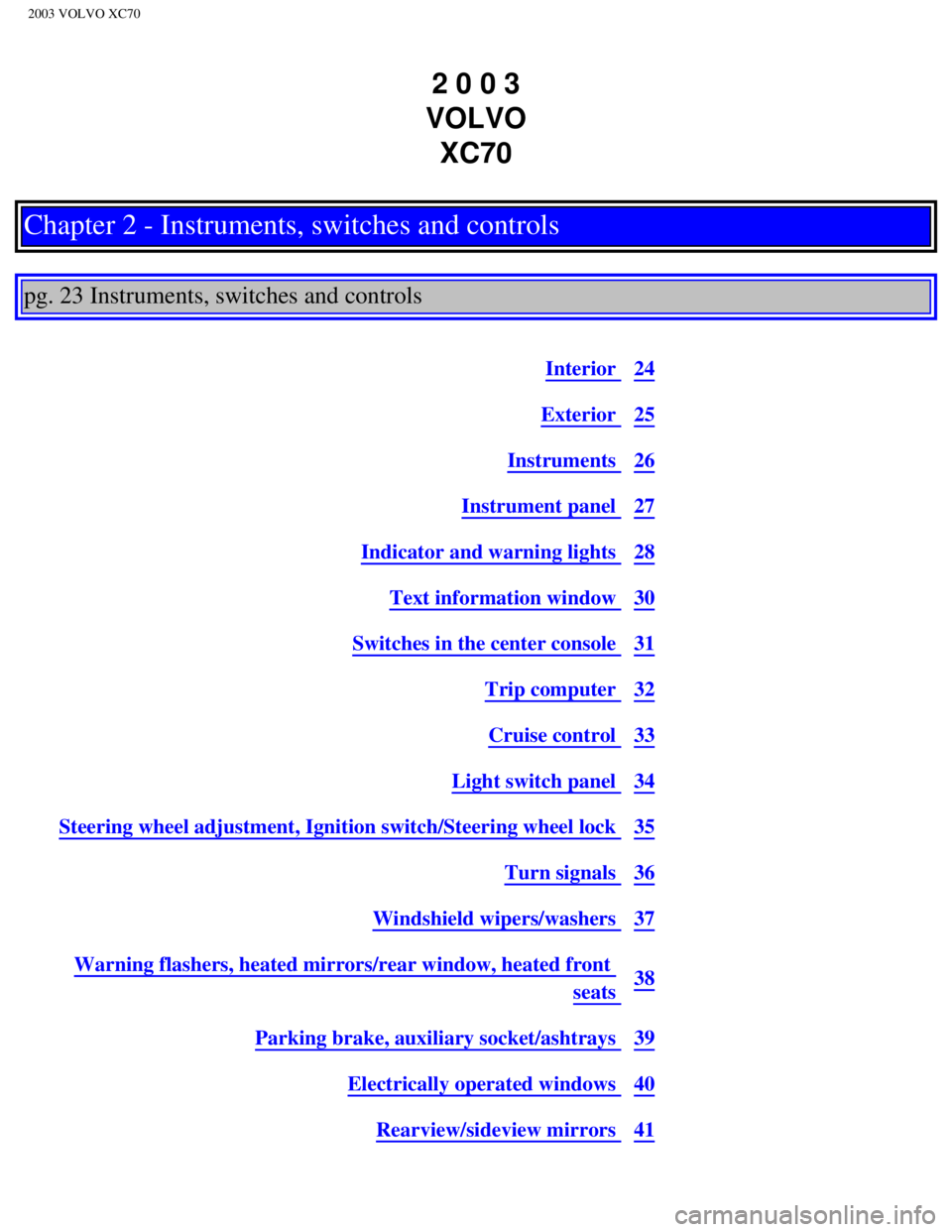
2003 VOLVO XC70
2 0 0 3
VOLVO XC70
Chapter 2 - Instruments, switches and controls
pg. 23 Instruments, switches and controls
Interior 24
Exterior 25
Instruments 26
Instrument panel 27
Indicator and warning lights 28
Text information window 30
Switches in the center console 31
Trip computer 32
Cruise control 33
Light switch panel 34
Steering wheel adjustment, Ignition switch/Steering wheel lock 35
Turn signals 36
Windshield wipers/washers 37
Warning flashers, heated mirrors/rear window, heated front
seats 38
Parking brake, auxiliary socket/ashtrays 39
Electrically operated windows 40
Rearview/sideview mirrors 41
file:///K|/ownersdocs/2003/2003_XC70/03xc70_02a.htm (1 of 13)12/30/200\
6 4:17:53 PM
Page 39 of 257
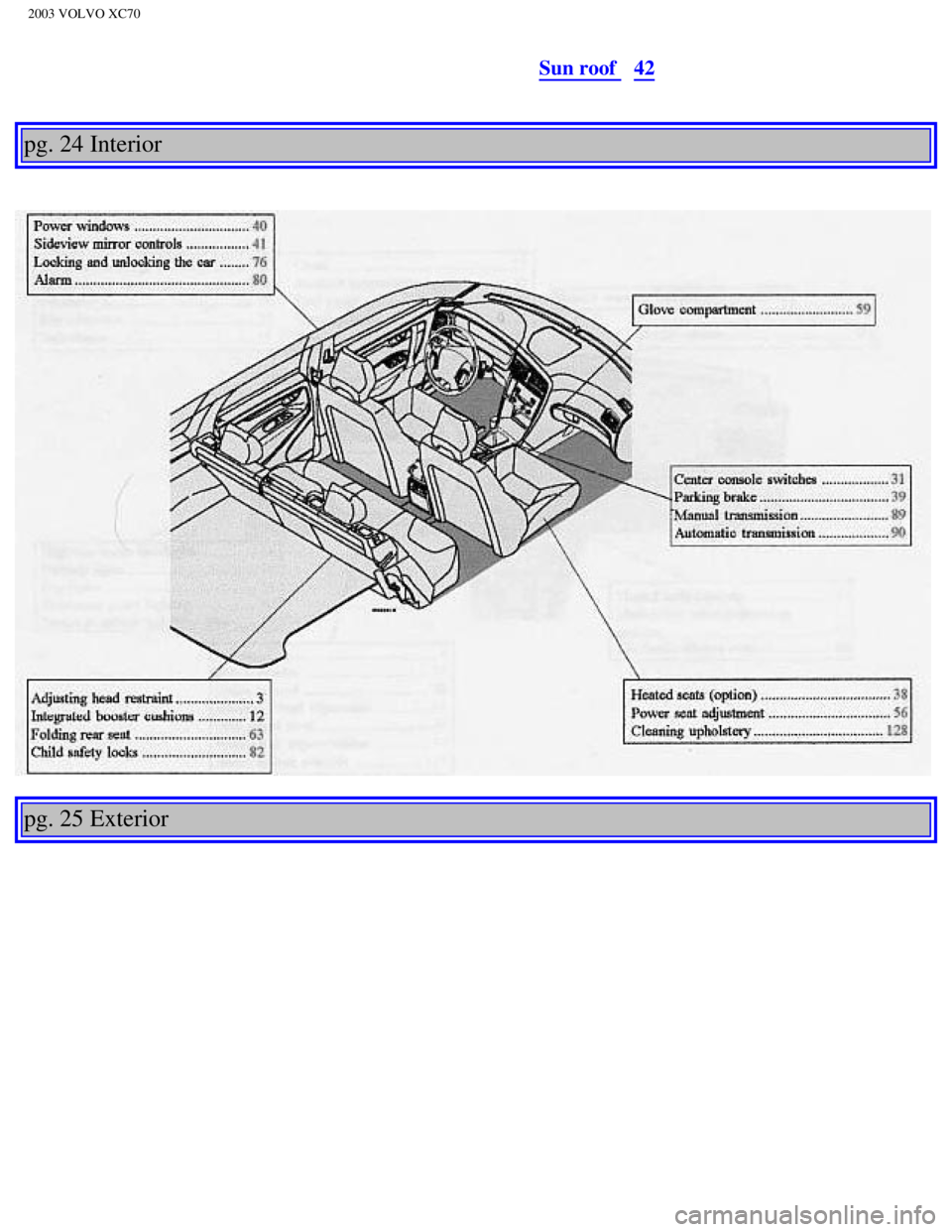
2003 VOLVO XC70
Sun roof 42
pg. 24 Interior
pg. 25 Exterior
file:///K|/ownersdocs/2003/2003_XC70/03xc70_02a.htm (2 of 13)12/30/200\
6 4:17:53 PM
Page 40 of 257
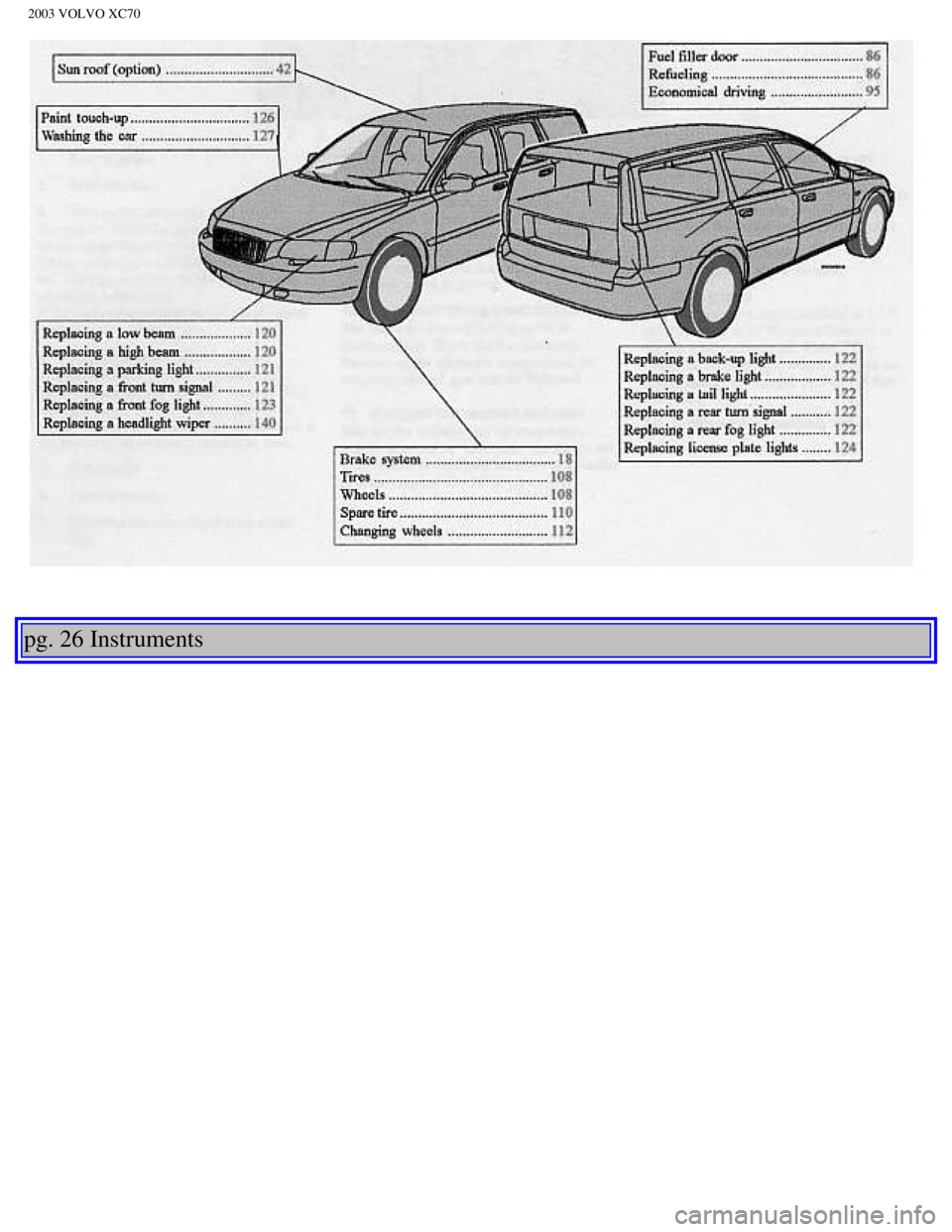
2003 VOLVO XC70
pg. 26 Instruments
file:///K|/ownersdocs/2003/2003_XC70/03xc70_02a.htm (3 of 13)12/30/200\
6 4:17:53 PM